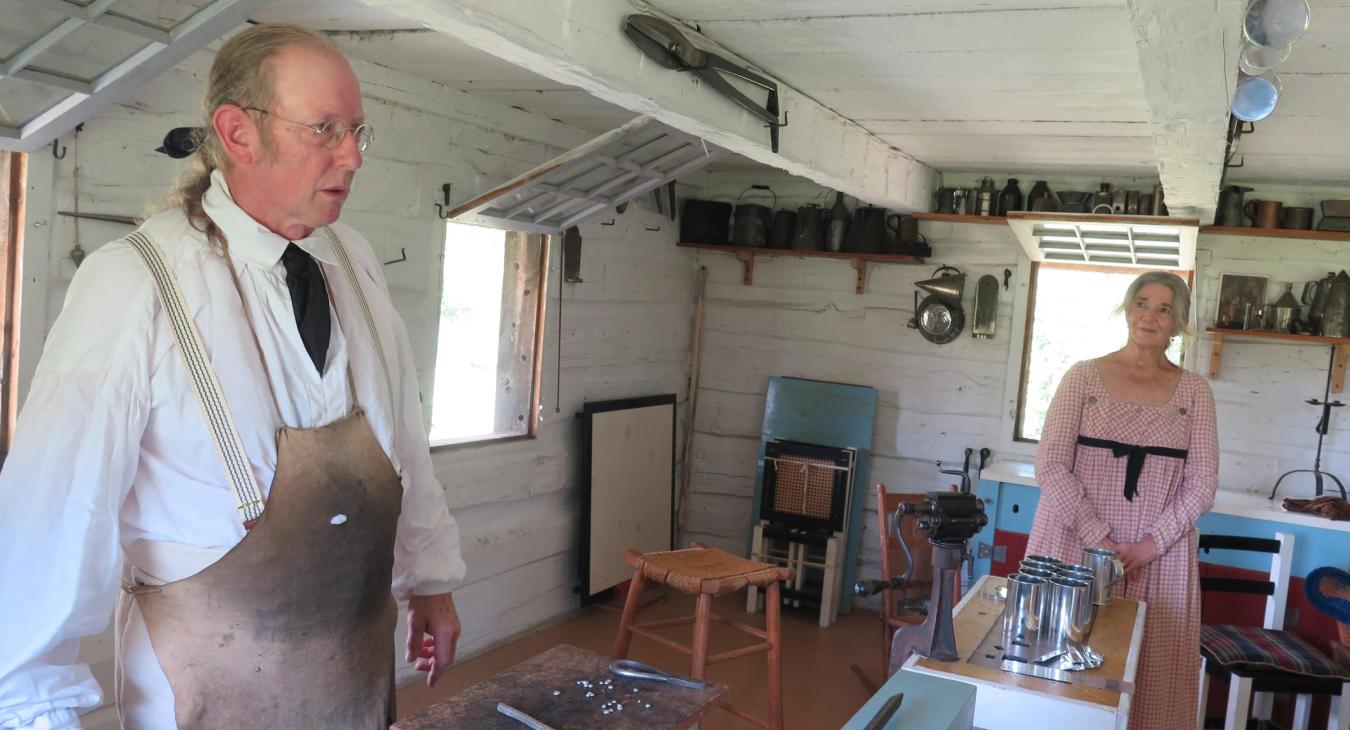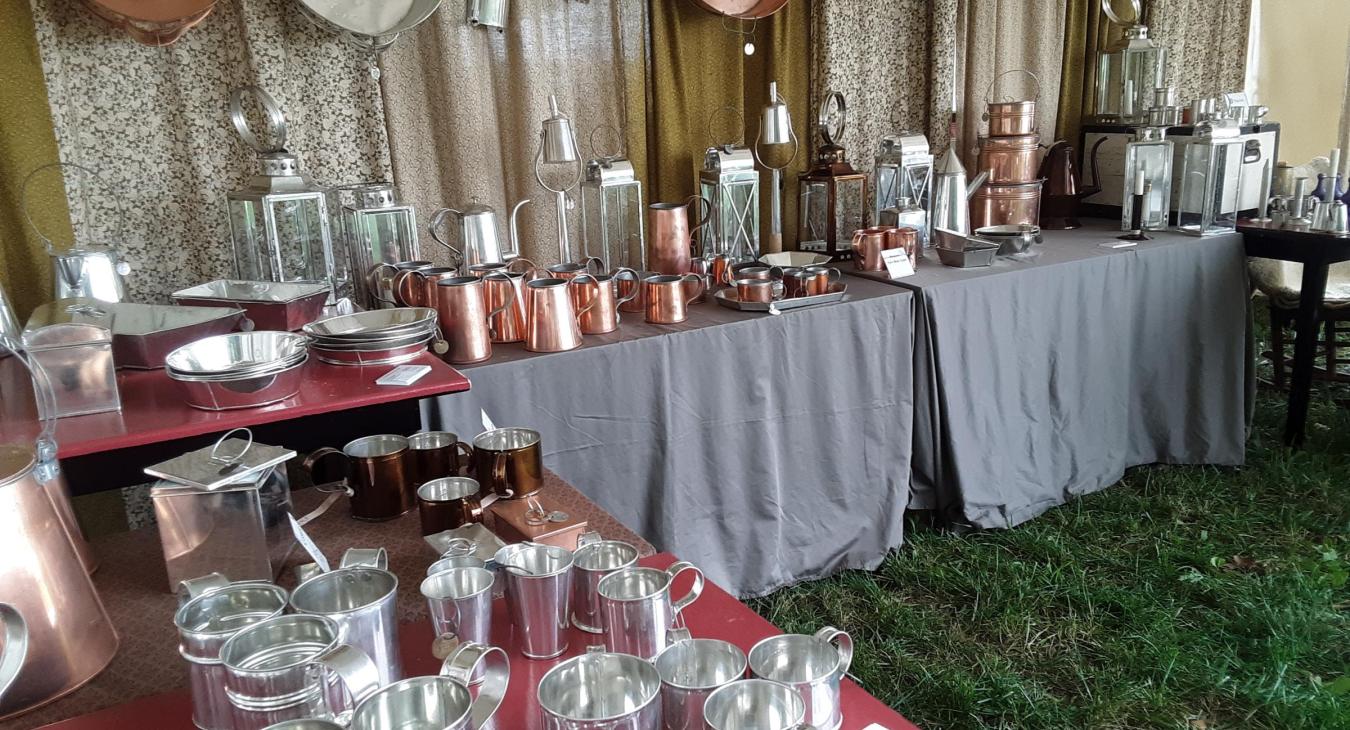By LaRayne Topp
Hand-operated machines designed to crimp, cut and construct pieces of tin line up on workbenches, while patterns for cups and pitchers, lanterns and candlesticks hang from rafters overhead. It’s the workspace of a craftsman who not only shapes tin into shiny and utilitarian vessels, lanterns and pails, he also displays and distributes his wares at historical events and arts festivals throughout the country.
Christian Hagemann and wife Linda, who sometimes introduces herself as Dorothy to her Tinman Wizard, make their home near Fort Atkinson State Historical Park, where he volunteers as a historical interpreter. As such, he guides visitors through the tinsmithing process, harkening back to a time when hand-made tinplate items for the home were in high demand.
Hagemann’s soft banter combines historical facts with his personal story as he talks, introducing his approach to metal work and all things tin. He mixes in a few jokes now and then which he will fire in a slow, black powder musket style, waiting with a steady eye and an easy smile to see if the listener has caught on.
As a military brat of a boy, he grew up in Virginia, and in 1974 he wound up making molded candles in Colonial Williamsburg. In 1976, during the nation’s Bicentennial, he transferred over to the Powder Magazine where he purchased a tinplated cup built by a tinsmithing craftsman, paying $10 for it. This was an amount his dad pronounced to be too expensive, although Hagemann hung on to that cup anyway. After all, this tinplated cup is what started it all.
As a student at Colorado School of Trades, Hagemann learned the art of Gunsmithing and later in his career specialized in custom pistols, designing and creating black powder muzzle loading target pistols. At various rendezvous—which are present-day gatherings of historical reenactors, reminiscent of the annual social gatherings between mountain men and other traders to exchange furs for essential supplies—he carried along his tinplated cup.
“It was the only one like it,” Hagemann recalled. “The rest had cheap cups and nobody knew how to make any of them.”
By the late 70’s, Hagemann found himself working in Bellevue where he restored antique firearms, including black powder handguns from the 1800’s. Moving on from there he worked in Fremont where in 1991 he became a member of the American Pistolsmith’s Guild.
In 1994, Chris happened to take in the White Catfish Camp Memorial Observance at Lake Manawa, Iowa, part of the Lewis and Clark Trail Centennial. It was there that a collection of shiny objects once again caught his eye including hand-made tin cups. The craftsman was one of the historical interpreters, a man from Kentucky.
For two decades, Hagemann had been carrying around the cup he bought while at Colonial Williamsburg, hoping to meet someone who could show him how to design one.
“You made these?” he said to the craftsman. “I’ve been waiting 20 years to meet you.”
The craftsman was a goldmine of information, providing an inside track on tinsmithing machines, kinds of metal, and places to find them.
Following that same weekend, in a convenient act of serendipity, Hagemann happened upon a place to purchase second-hand tinsmithing mandrils or “stakes” for a price Chris described as a “smoking deal.” Although these stakes were rusty, he was able to clean and polish them to a usable and nearly-new state. Later, he found another local place that sold tinsmithing machines. As he took each one apart to clean its individual parts, he figured out how each one worked.
“There wasn’t anyone around to teach me how; I just discovered it a little bit at a time.”
Hagemann believes these machines were conceived by left-handed inventors. Each of us has a “dumb hand” and a “smart hand,” Hagemann said, based on our dominant hand. The cranks on these machines are operated by the right or “dumb hand,” Hagemann explained, and tinplate is guided through each machine with the left, or “smart hand,” a task that can seem impossible for a right-hander.
“Finally, I found something that was as difficult for a right-handed person as my life has been as a lefty,” he said.
Various machines and mandrils are used throughout the creative processes: bending, shearing, body forming, seaming, soldering, wiring and beading machines. Chris begins with a sheet of tinplate metal, which he purchases in sheets of food grade quality in lots of 100 or more. He measures and cuts the sheets, depending upon which pattern he is using, bends the cut sheet into its required shape, creates the seams and solders all together, riveting on bails and handles where needed. He uses basic geometry, algebra and mathematics to design each item, then cuts and shapes, joining the pieces to create the main body.
It sounds simple enough. However, the first time Hagemann attempted to make a pattern from and reproduce his first cup, he fashioned a dozen.
“Six of them didn’t leak,” he said, so he sold five of those at $10 apiece.
A phone call to his dad followed, reminding Hagemann’s father of Chris’s first tin cup purchase for $10.
As Hagemann began to display his tin cups, requests for other items followed: Can you make a bowl? A bucket? A lantern? A coffeepot? Today, Hagemann has reproduced and created patterns for more than 140 different items, a list which is still growing. (To obtain a catalog, you can contact Hagemann at Tinnmann56@gmail.com or 402-650-8612.)
In December of 2005, a motorcycle accident changed the course of Hagemann’s life in more directions than one, an event he describes as a “cosmic revelation.” Not only did the resulting broken ribs and spine, punctured lungs and brain hematoma leave him with an awareness of the fragility of life, plus a lengthy recovery, it also helped him walk away from a profession he’d held for more than 30 years.
As a result, he turned his part-time tinsmithing hobby into something that by 2009, had become his calling. He doesn’t call it a job, because, as he said, “It’s not work if you enjoy it.”
For more than 30 years, Chris Hagemann has been a regular presence at Nebraska’s Fort Atkinson State Park. Fort Atkinson was an active military post from 1819 to 1827, established as the main fort for the Yellowstone Expedition and designed to enforce the ownership of the newly purchased Louisiana Territory.
Fort Atkinson is located at Fort Calhoun, a town named for John Calhoun, a South Carolina statesman who served at Secretary of War in 1854 when the Territory of Nebraska was created. (Today, the primary electric supplier for the Fort Calhoun area is the Metropolitan Utilities District.)
In many ways, Hagemann is walking back in time in the footsteps of Milo Moses, a soldier and tinsmith who actually practiced his trade at the fort in the early 19th century. Hagemann’s historical interpretation is as someone who happened to know Moses.
“I use his era tools as much as I can,” Hagemann said.
Some of Hagemann’s wares are sold in the Fort’s Sutler Store, as well as at other events he frequents: rendezvous, market fairs, outdoor expositions, Nebraska Game and Parks experiences, arts festivals and indoor trade shows across the United States. He is one of only a dozen or so tinsmiths in the United States who can profess to make a living at this craft.
Hagemann attends these events as a tinsmith, vendor and proprietor of Amalgamated Tin Ware. He also takes part in competitions involving bow and arrow and muzzle loading firearms once used by trappers and traders.
And all because a shiny tin cup led him back to an earlier time.


